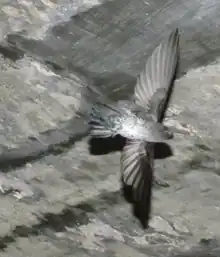Plume-toed swiftlet
The plume-toed swiftlet (Collocalia affinis) is a small bird in the swift family Apodidae. It is found on some eastern Indian Ocean islands, the Malay Peninsula, Sumatra, and lowland Borneo.
| Plume-toed swiftlet | |
|---|---|
 | |
| Scientific classification | |
| Domain: | Eukaryota |
| Kingdom: | Animalia |
| Phylum: | Chordata |
| Clade: | Dinosauria |
| Class: | Aves |
| Clade: | Strisores |
| Order: | Apodiformes |
| Family: | Apodidae |
| Genus: | Collocalia |
| Species: | C. affinis |
| Binomial name | |
| Collocalia affinis Beavan, 1867 | |
| Synonyms | |
|
Collocalia esculenta affinis | |
Its natural habitat is subtropical or tropical moist lowland forests. It was previously considered a subspecies of the glossy swiftlet.

Taxonomy
The plume-toed swiftlet was described by the English ornithologist Robert Cecil Beavan in 1867 and given current binomial name Collocalia affinis. The type locality is Port Blair in the Andaman Islands.[1][2] The specific epithet affinis is Latin for "related" or "applied".[3] The plume-toed swiftlet was previously treated as a subspecies of the glossy swiftlet but was promoted to species status based on the results of a detailed analysis of the swiftlets in the genus Collocalia published in 2017.[4][5]
There are five subspecies:[5]
- C. a. affinis Beavan, 1867 – Andaman and Nicobar Islands in the eastern Indian Ocean
- C. a. elachyptera Oberholser, 1906 – Mergui Archipelago off the west coast of southern Myanmar
- C. a. vanderbilti Rodolphe Meyer de Schauensee & Ripley, 1940 – Nias Island off the west coast of Sumatra
- C. a. oberholseri Stresemann, 1912 – Batu and Mentawai Islands off the west coast of Sumatra
- C. a. cyanoptila Oberholser, 1906 – Malay Peninsula, Sumatra, Natuna Islands and lowland Borneo

Description
The plume-toed swiftlet is 9–10 cm (3.5–3.9 in) in length with a square tail.[6] The back and upper surface of the wings are uniformly dark greenish-blue with a moderate gloss. The throat and upper breast are dark grey merging into large greyish chevrons over the lower breast and flanks, usually becoming white over the belly. There is a tuft of small feathers on the hallux, the rear facing toe. This species lacks a pale contrasting rump and has no white spots on the inner webs of the tail feathers.[4]
References
- Beavan, Robert Cecil (1867). "The avifauna of the Andaman Islands". Ibis. Series 2. 3: 314–334 [318]. doi:10.1111/j.1474-919X.1867.tb06434.x.
- Peters, James Lee, ed. (1940). Check-list of Birds of the World. Vol. 4. Cambridge, Massachusetts: Harvard University Press. p. 229.
- Jobling, James A. (2010). The Helm Dictionary of Scientific Bird Names. London: Christopher Helm. p. 35. ISBN 978-1-4081-2501-4.
- Rheindt, Frank E.; Christidis, Les; Norman, Janette A.; Eaton, James A.; Sadanandan, Keren R.; Schodde, Richard (2017). "Speciation in Indo-Pacific swiftlets (Aves: Apodidae): integrating molecular and phenotypic data for a new provisional taxonomy of the Collocalia esculenta complex". Zootaxa. 4250 (5): 401–433. doi:10.11646/zootaxa.4250.5.1.
- Gill, Frank; Donsker, David, eds. (2017). "Owlet-nightjars, treeswifts & swifts". World Bird List Version 7.3. International Ornithologists' Union. Retrieved 2 August 2017.
- Chantler, P.; Boesman, P. (2017). del Hoyo, J.; Elliott, A.; Sargatal, J.; Christie, D.A.; de Juana, E. (eds.). "Glossy Swiftlet (Collocalia esculenta)". Handbook of the Birds of the World Alive. Lynx Edicions. Retrieved 23 August 2017.